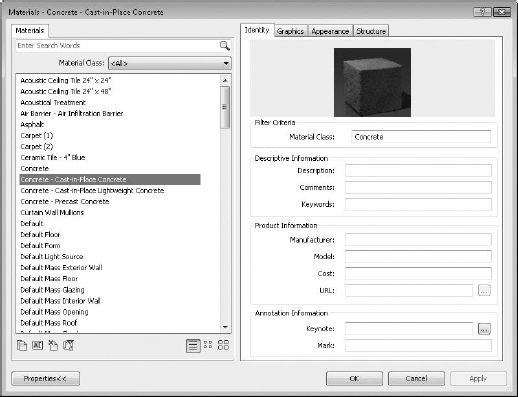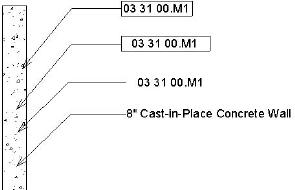Annotating with Text and Keynotes
Notes are a critical part of communicating design and construction intent to owners and builders. No drawing set is complete without descriptions of materials and the work (Figure 19.1).
FIGURE 19.1 An annotated detail

Revit has two ways for you to note your drawings. Both are located on the Annotate tab and highlighted in Figure 19.2. One of these methods is the Text command (shown on the left), and the other is the Keynote command (shown on the right).
![]()
The Text command in Revit consists of a field you can enter type into with or without a leader, bullets, or numbers. Text can be used for annotations, sheet notes (such as General Notes), legends, or generally anywhere you need to add a description or a note. Keynotes are pre-described text fields that are linked to elements and materials through a data file. Keynotes can be scheduled and standardized across the project but can't be directly edited within Revit. Both keynotes and text have specific uses across the project. Let's look at both.
Using Text
Text is quick and easy to add to any view (including 3D views) and, like other drafting elements, is view specific. Text added to one view will not appear in any other location within the model, nor will the actual type that you insert into the text box hold any sort of parametric values.
You can access the Text tool from the Text panel on the Annotate tab (shown earlier in Figure 19.2).
To begin adding text, simply select the Text tool, choose a location to insert the text, and start typing. You'll be presented with the standard Revit crosshair, but it will have a small A in the lower corner ![]() to let you know you are adding text and not other elements. The Text tool will allow you to write much as you do in applications like Microsoft Word. Once you are done typing, simply click outside the text box.
to let you know you are adding text and not other elements. The Text tool will allow you to write much as you do in applications like Microsoft Word. Once you are done typing, simply click outside the text box.
Your finished text box will look like Figure 19.3. You'll also notice that once you're finished with your initial text, you have a few tools available:
FIGURE 19.3 A highlighted text box
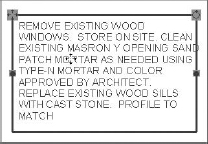
Grips The round grips on either side of the text box allow you to resize the box.
Move There is a move icon that appears in the upper-left corner of the text box. In addition, hovering your mouse anywhere within the highlighted text will also display a move cursor. You can click and drag from within the box or click the move icon on the upper-left corner to relocate it. When you're moving text with the move icon (or the Move command), the text and leader will relocate together. When you're moving text by dragging, the leader end will remain pinned while you relocate the text box. These methods let you move either the text or the text and the leader, depending on your need.
Rotate The upper-right corner will show a rotate icon. Clicking this icon allows you to rotate the text box as you would any object within Revit. Remember that text within Revit will always position itself to be read from the bottom or right side of the screen, drawing, or view.
The Text family behaves like other Revit families, and text families maintain a parametric relationship throughout the project. Making changes to a text family in one location (changing font, font size, color, and so on) changes all the instances of that family throughout the model. To modify a text family, simply select a block of text or choose the Text tool. This will open the Type Selector, shown in Figure 19.4.
FIGURE 19.4 Type Selector for text

Here, the controls are rather limited and deal primarily with instance parameters for an individual instance of text (alignment, location, and so on), which you can also set on the ribbon. The Type Selector also allows you to change type or edit the text family. Click the Edit Type button, and it will open the text family's properties. Figure 19.5 shows the properties for Text 3/32″ [3 mm] Arial.
FIGURE 19.5 Type Properties dialog box
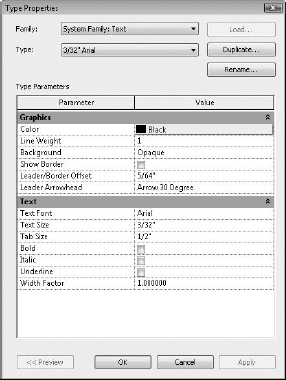
In this dialog box, you have more control over the style of the text. Here you can modify typical text properties, such as font style and size and width factor, and you can add formatting to the font, such as bold, italic, and underline.
At any time within the Text command or when the text box is selected, additional tools become available on the ribbon. The Format panel is divided into four sections that allow you to modify the instance of the text you've placed. Figure 19.6 shows the Format panel. Let's look at this panel in some more detail to better understand the toolset:

![]() Leaders The leftmost section of this panel allows you to designate the type and style of leader you want to add to your text box. By default, the upper-left A is selected (as in Figure 19.6), which designates that no leader is currently added. The other choices all will add a leader to the text. Reading from left to right, the options are no leader, a single segment leader, a double-segment leader, and an arced leader. Leaders can be added at any time when you're placing or editing text and can also be removed at any time. Remember that when you're removing leaders, they will disappear in the order they were added.
Leaders The leftmost section of this panel allows you to designate the type and style of leader you want to add to your text box. By default, the upper-left A is selected (as in Figure 19.6), which designates that no leader is currently added. The other choices all will add a leader to the text. Reading from left to right, the options are no leader, a single segment leader, a double-segment leader, and an arced leader. Leaders can be added at any time when you're placing or editing text and can also be removed at any time. Remember that when you're removing leaders, they will disappear in the order they were added.
Leader Location The second portion of this panel dictates leader location. Leaders can be added to the left or to the right and at the top, center, or bottom of the text box. Figure 19.6 shows the default with a left leader springing from the upper left of the text; leaders that spring from the right side typically come from the end of the text box (at the bottom). A double-segment leader springing from the left and right will look like Figure 19.7.
FIGURE 19.7 Text with a leader
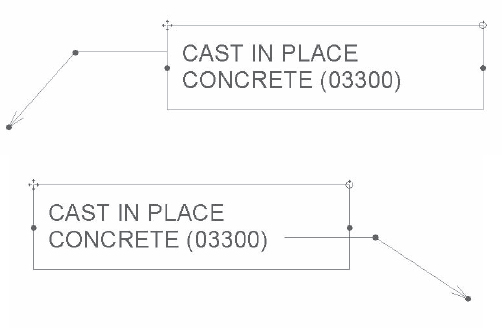
Format The third portion of the text box controls the format of the text. These features— justification, bold, italicized, and underline—can also be modified using the Properties Pallete shown previously in Figure 19.4.
Bullets The rightmost portion of the Format panel allows you to add a bulleted or numbered list to the text box. By default, this style of formatting is not added, but by selecting the text box or the text within the box, you can add bullets, number, or letters to the text. Figure 19.8 shows the bulleting and numbering options.
FIGURE 19.8 Text notes with bullets

Using Keynotes and Text Notes
Keynotes are written annotations that relate text to specific elements or materials in the model using an external file. You can control the formatting of the font style, size, and justification in the same manner you can format standard text, but keynotes and text notes behave more like a typical Revit family. Using keynotes, you can insert different family types of text into the model, just as you would door or window families. These inserted families contain text that is not directly editable but instead is tied to an external TXT file. Inserting a keynote allows you to choose a value from the file and apply it to a material or element. Because keynotes and text notes act as families in Revit, they can also be scheduled where standard text cannot. Although the Revit command is called Keynote, Revit can produce keynotes, text notes, or a combination of both. Before we discuss how to add those note types, we'll cover the differences between a keynote and a text note.
A keynote is a short numeric reference followed by a two-letter suffix. The keynote references a list or schedule located on the same sheet the note is placed that has a longer definition of the note. As an example, a keynote on a detail might read “033000.AA” with a leader pointing to an element in the drawing. The associated list on the side of the sheet would read “CAST IN PLACE CONCRETE.” Figure 19.9 shows an example of a keynote legend.

In contrast to keynotes, text notes are the full, written description directly within the detail or view without the numeric reference key. Figure 19.10 shows an example of a text note.
FIGURE 19.10 Text notes with keynotes
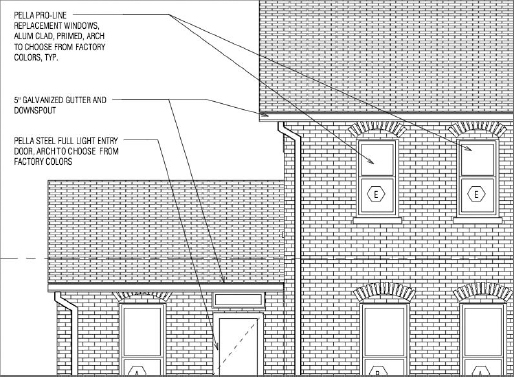
There is no wrong system to use, and Revit supports both ways of annotating sheets. Regardless of the method you use, the keynotes will adhere to the same process for use. Once an element is tagged with a keynote, it will retain that keynote in all other views in the model. If an element that has been tagged with a keynote in one view is then annotated in another view, it will automatically pull up the same keynote value. This can become a very powerful tool you can use to add consistency throughout the model for annotated elements.
The Keynote command is located on the Annotate tab. When you select the Keynote tool, you have three note type options:

Element Use Element notes to keynote elements and assemblies within the model such as walls, doors, floors, or other family instances. This type of note is typically used if you want to annotate an entire assembly (such as a wall). Moving the Element keynote leader arrow off the wall will dynamically change the value of the note based on the element it points to. The keynote value can be preset for different family types within a template in the element's properties. We'll go into how to do that later in this chapter.
Material Using the Material note type will allow you to annotate specific materials within any elements. You can add notes for materials like concrete, gypsum board, rigid insulation, metal studs, and the like. Moving the Material keynote leader arrow off the wall will dynamically change the value of the note based on the material it points to. Material notes can also be predefined as part of your template. Material notes can be used in conjunction with Element notes.
User This option allows you to select any model-based component in Revit and define a custom keynote for it. Notes defined this way differ from those defined as Element or Material because they're not unique to the particular object selected. Once you move the keynote leader arrowhead, the note will not dynamically change. User-defined notes are static in that sense. They can be used in conjunction with Element and Material notes on any object but cannot be predefined.
You can use all of these note types in conjunction with one another. Using an Element note to add a keynote to a wall doesn't mean you cannot also use a Material note to call out the individual materials in the wall assembly.
KEYNOTE BEHAVIOR AND EDITING
A core concept of the Keynote tool is how the notes react with in the model. Keynoting an object in Revit lets you associate a text or numeric value with a family's keynote parameter. This value is consistent for every instance of that element within the model or project. For example, all walls have a type parameter called Keynote that lets you set the keynote value. If you keynote a wall anywhere within the model, the keynote value in the type parameter will reflect that note. Consequently, any other wall of that type will be prepopulated with that keynote value. Changes to this keynote value will dynamically update the type parameter value and update any keynotes placed within the model tagged to this wall.
It's important to think of a keynote as a family type because keynotes will act more like a Revit family than they will like text. Keynotes behave similar to other Revit families in that you cannot edit the keynote directly within the model. All keynotes within the model are tied to an external TXT file. This TXT file is the only location where the value of the keynotes can be edited. This file can be modified at any point to add or remove notes and the edits can happen while the project is actively open. Figure 19.11 shows a sample portion of the file.
FIGURE 19.11 The Keynote TXT file
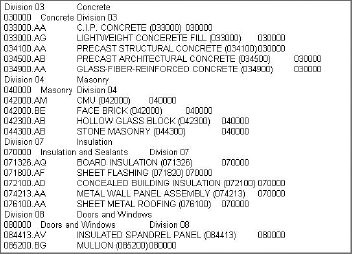
This external file is designed to keep the annotations consistent by storing them in one repository. Every time you add or change a note value and reload the TXT file back into the Revit model, all of the notes of that type dynamically update.
You can edit this TXT file or add one to the project at any time. You can have multiple keynote files for various projects, but you can have only one TXT file per project at a time. Revit does not allow for multiple keynote files to be linked to the model simultaneously.
MANAGING KEYNOTES
A great way to ensure consistent use of notes throughout multiple projects is to create a master keynote file for your various project types. This master note list can be linked to elements and materials with your project template so that you can immediately begin inserting common notes into any project. Since this file will commonly be long as a master list, project teams can make a copy of the list and place it in their project directories. They can then safely delete the notes they won't be using over the course of the project, giving them fewer options to hunt through when they need to add a keynote.
Having a centrally controlled keynote file also gives project management a level of control over the consistency of the notes that you won't be able to get if you use regular text. Spelling accidents or mislabeling can happen in a project. Using regular text, it's easy to overlook a note that reads “CIP CONCRETE” on one detail and “CAST-IN-PLACE CONCRETE” in another. By placing all the notes into one centralized file, the project manager or project architect has better control over how the note reads and ensures consistency throughout all the sheets and details.
Because the keynote file is a separate TXT file, remember that when transferring files to other offices or clients you'll need to include the TXT file as well as the RVT file if you are going to share information. If you don't send the TXT file, others will be able to see all of your notes but won't be able to change or edit any of them.
THE KEYNOTE FILE
Three keynote text files come with Revit by default. You can find all of them in C:Documents and SettingsAll UsersApplication DataAutodeskRAC 2012Imperial Library (be sure to unhide hidden folders or start in the Program Data folder for Windows 7). These three keynote files are called RevitKeynotesImperial.txt, RevitKeynotesImperial_2004.txt, and RevitKeynotesMetric.txt.
Edit any of these files in Notepad or Excel, and follow the format already established within the file. Let's look at the format of this file so you can understand how to customize the keynotes.
The first few rows of the file (Figure 19.12) designate the grouping of the notes. In this example, they consist of a label (Division 03) followed by a tab and then a description (Concrete).
FIGURE 19.12 The Keynote TXT file header
![]()
Directly below this header is a secondary, or minor, grouping. This secondary grouping follows the same format as the primary group and provides better control over how the keynotes are displayed within Revit. This line follows the same format as the first: Label (033000), then a tab, then a description (Concrete), then another tab, then another description (Division 03). In this line, the description needs to match, identically, the label in the line above. This designates the second line as a subset to the first line. You can add as many or as few subgroups as you'd like. In our case, we have subcategories for each division, but that's not necessary.
Below the grouping are the contents of that group. These lines are articulated in the following format:
Label, Tab, Description (note body), Tab, Grouping
In the previous example in Figure 19.12, this reads as follows:
033000.AA [tab] C.I.P. CONCRETE (033000) [tab] 033000
where the [tab] is an actual tab, not the text.
To get an idea of how this will all look once loaded into Revit, Figure 19.13 shows you the Keynote dialog box with Division 7 expanded.
FIGURE 19.13 The keynote file loaded into Revit

Using the keynote file approach lets you add, remove, or edit notes and groups of notes. This might seem frustrating to have to open and load a separate TXT file every time you want to add or remove notes from the keynote list. However, remember that this also maintains consistency and a level of control over the master list that isn't available with simple text. Although it might be slow at stages to get all the project notes into the TXT file, it also means that the time you'll spend checking and verifying the notes is dramatically reduced.
Should managing keynotes directly in a TXT file not be a workflow you would like to maintain, tools are available online to help you manage keynotes using a graphic interface. Emc2 has a great tool (www.emc2architects.com/revit_tools.html) that will manage your keynote list, create headings and subheadings, and format the TXT file in a way that Revit can read. Tools like this are great for speeding up the editing process for keynotes and maintaining proper formatting of the TXT file.
KEYNOTE SETTINGS
Now that the Keynote TXT file is established and you've begun populating it with annotations, you need to link it to the Revit model. Loading this file into the Revit project is simple and needs to happen only once during the project. Additionally, loading this keynote file is a project setting, not a user one, so once the file is linked, all the users will have access to the keynotes.
To access the keynote settings and load the keynote text file, choose the Tag flyout from the Text panel on the Annotate tab (Figure 19.14) and select Keynoting Settings.
FIGURE 19.14 Choose Keynoting Settings.
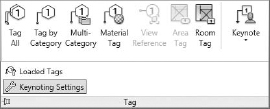
This command will open the Keynoting Settings dialog box (Figure 19.15). Here, you can define the project's keynote file as well as adjust some other settings. To load the keynote file, click the Browse button and navigate to the TXT file you've created.
FIGURE 19.15 Keynoting Settings dialog box

The following are some of the other variables you can set in the Keynoting Settings dialog box:
Path Type Path Type defines how Revit looks for your text file using one of three methods:
Numbering Method Numbering Method defines how the keynotes are numbered:
LOADING KEYNOTES
Once the keynote TXT file is loaded into Revit, it is available for the team to use. As we've mentioned, changes can be made to this file on the fly while the project is open and active. Although this is true, when changes are made to the keynote file and the project is opened, the keynote file will need to be reloaded into the project for the changes to be visible to other team members. There are two ways to do this:
- Open the Keynoting Settings dialog box and browse back out to the TXT file and reload it. Once this is done, you'll need to Synchronize With Central (if the project is workshared) and your team members will also need to SWC to gain access to the changes.
- Close and reopen your Revit project file.
KEYNOTE TYPES
To add keynotes to a Revit model, choose one of the three keynote types from the Annotate tab; then in your view, select the object you want to annotate and insert a keynote. Keynotes insert in an arrowhead, segment, note sequence. The arrowhead location will also define the element or material if you are using one of those note types. If the object doesn't have a note already defined, you'll be prompted to pick a note from the keynote list. Figure 19.16 shows a sample of this list.
FIGURE 19.16 Choosing a keynote to insert
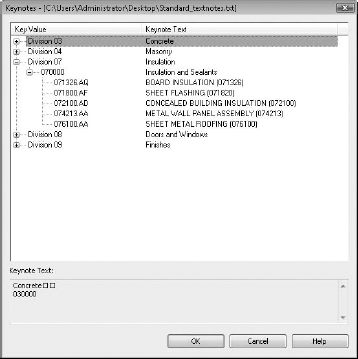
Before inserting a keynote, we'll cover the three types of notes and explain how each might be used.
Element
Element keynotes will annotate an assembly (walls, floors, roofs, and so on) or a component or family (doors, windows, furniture, and so on) within the model. Once keynoted, the assembly or component will capture the keynote value within the object's type properties. In Figure 19.17 you can see the Keynote value is filled in for the Roof type, Basic Roof.
FIGURE 19.17 Keynote value in the object's type properties

Alternatively, you can set this value through the object properties. By clicking the button next to the keynote value ![]() , you will open the Keynote list, which allows you to preselect a keynote for the element. For elements that are more universally used from project to project (such as cast-in-place concrete walls), you can preset values within your project template. The Element keynote is the first option you can select from the Keynote flyout (Figure 19.18).
, you will open the Keynote list, which allows you to preselect a keynote for the element. For elements that are more universally used from project to project (such as cast-in-place concrete walls), you can preset values within your project template. The Element keynote is the first option you can select from the Keynote flyout (Figure 19.18).
FIGURE 19.18 Keynoting elements

When using an Element keynote to tag an assembly within Revit, simply click anywhere on the assembly. A tagged roof condition looks like Figure 19.19.
FIGURE 19.19 Using the Element keynote on a roof assembly

Material
Material keynotes define the materials within a model. Whereas the Element keynotes can be used to define an assembly, Material keynotes can be used to define the materials within that assembly. For example, you can use an Element keynote to annotate a gypsum board wall assembly and a Material keynote to designate the layers of gypsum board and the metal stud in between.
To tag materials using the Material keynote, select the Material Keynote button and hover your mouse over the materials comprising an assembly. As you hover over the various materials, you'll notice that predefined materials will show the note value and undefined materials will give you a question mark. Tagging the same roof assembly, you can specify all the materials that make up the roof element (Figure 19.20).
FIGURE 19.20 Keynoting materials
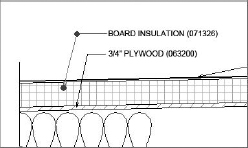
The Material Keynote tool is the second tool located on the Keynote flyout on the Annotate tab (Figure 19.21). You'll notice that once you begin using any of the keynote tools, the last tool used will take the default icon location in the Text panel. In Figure 19.21, you'll see that this is currently set to the Material keynote.

Like Element keynotes, Material keynotes can be predefined. To predefine these note types, click the Materials button in the Manage tab (Figure 19.22).
FIGURE 19.22 Predefining the Material keynotes

Selecting the Materials button opens the Materials dialog box. To predefine a material's keynote, select it from the list on the left and choose the Identity tab (Figure 19.23).
FIGURE 19.23 The Identity tab of a material
At the bottom of this tab is the Keynote field. Selecting in this field will allow you to click the same ![]() button you selected when predefining an Element keynote. You'll be presented with the Keynotes dialog box and can select a note to apply to your material (Figure 19.24).
button you selected when predefining an Element keynote. You'll be presented with the Keynotes dialog box and can select a note to apply to your material (Figure 19.24).
FIGURE 19.24 Adding a keynote to a material
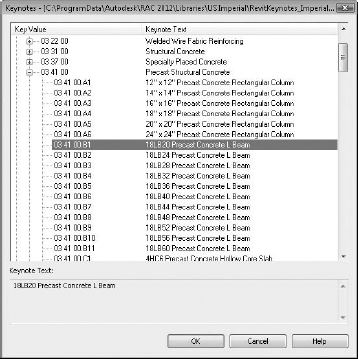
Defining the note will enter a value into the Keynote field, as shown in Figure 19.25. As with Element keynotes, you can predefine a number of keynote values as part of your project template.
FIGURE 19.25 A material with a defined keynote

User
User Keynote is the third tool on the Keynote flyout (Figure 19.26). User keynotes are different from Element and Material keynotes because they are view specific and cannot be predefined. Although they are still tied to the same TXT file and will update in the same manner as other keynotes, they are not tied to any geometry in Revit. User keynotes are meant to be used for all the instances when you don't have a modeled element or material but you still need to define a note. Some examples of things you wouldn't necessarily model would be sealant, backer rod, or flashing.

User keynotes are used primarily in drafting views. To use any keynote, a given view must have at least one model element or component visible within it. In the case of a drafting view, you will need to insert a 2D component (such as wood blocking or a steel stud) because keynotes cannot be used to note linework. Because User keynotes are not locked to specific model geometry, once they are inserted they can easily be copied or moved around within the view and pointed to any element. In this way, if you have sealant or flashing shown as linework, you can add a User keynote to the view, and then adjust the note leader and the note value to call out the sealant properly. You can change the value of a user keynote at any time simply by double-clicking the note value; this modification will not affect any other notes within the project.
KEYNOTE LEGENDS
Depending on your choice of keynote and your workflow, you might want to create a legend on each sheet for your notes. You might want only the keynotes that are on a given sheet to appear in the legend. Or you might want to have one legend for the entire project that will show all keynotes used in the project.
These lists usually reside on the side of the drawing near the title block information and can take one of two forms. The first type is all-inclusive and shows every note within the project. This style has the benefit of consistency between sheets in the set. The same note will always be in the same location in the list. The other type of keynote list includes only the notes that show up on a particular sheet. This has the advantage of supplying a list of notes customized for each sheet without extraneous information. Creating either list manually has traditionally been challenging. One of the benefits of Revit is the ability to automate either list, thus removing much of the chance for error in the process. Let's review how to create both types of lists.
Creating a keynote legend in Revit is simple: choose the Legend button on the View tab and select Keynote Legend from the drop-down list (Figure 19.27). Once you click the Legend button, name the keynote legend, and then click OK.
FIGURE 19.27 The Keynote Legend button

You'll be presented with what looks like a typical schedule dialog box called Keynote Legend Properties. There are only two fields available in a keynote legend, and by default, they are both loaded into the Scheduled Fields side of the Fields tab (Figure 19.28). Those fields are as follows:
FIGURE 19.28 The Fields tab of the keynote legend
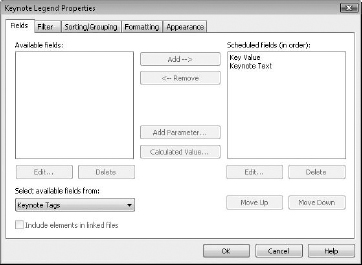
Key Value This field contains the numeric value of the keynote.
Keynote Text This field contains the text value for the keynote.
A keynote legend works like any other schedule as far as formatting and appearance goes. By default, the sorting and grouping are already established because the key value is used to sort. The one special item of note is located on the Filter tab. At the bottom of this tab is a feature unique to this type of schedule: a Filter By Sheet check box (Figure 19.29). Selecting this box gives you the ability to filter the list specifically for each sheet set; leaving the box deselected will supply a full list of the keynotes over the entire project.
FIGURE 19.29 The Filter By Sheet check box is located at the bottom of the Filter tab in the Keynote Legend Properties dialog box.
As with any legend, they can be placed on sheets again and again within the project. You're not limited to only one instance of the legend on a sheet as you are with other view types. Additionally, if you choose the keynote legend that filters by sheet, it will dynamically modify the note list based on individual sheet contents. As views are added or removed from a sheet or notes are added to the project, the keynote legend updates accordingly.
Keynote legends are considered to be another type of legend view and will appear under the Legends node of the Project Browser.
A SCHEDULE FOR KEYNOTES
Creating a schedule for keynotes is a great way to find single-use notes and typos in a project. If you are working on a project team, there's always a chance that someone could be inserting an incorrect keynote into the project. Scheduling the notes is an efficient approach to managing this process and gives you the tools to verify consistency. Scheduling keynotes allows you to do three things:
- List all the notes within a project and verify their spelling and accuracy.
- Find odd or one-off instances. Sometimes this can mean the note was accidentally placed in lieu of another note.
- Make sure all the keynotes in the project are represented in the specifications.
THE KEYNOTE FAMILY
Revit comes with a default Keynote family that allows you to produce both keynotes and text notes using the default keynote TXT file. The family name is Keynote Tag.rfa. This family has four types that let you change note styles within the project. You can see the four note styles in Figure 19.30.
FIGURE 19.30 Keynote styles available in the default tag
Here are the four default styles:
- Keynote Number
- Keynote Number – Boxed – Large
- Keynote Number – Boxed – Small
- Keynote Text
Each of these notes pulls information from the text file we discussed earlier in this chapter and reports it at the end of the leader.

